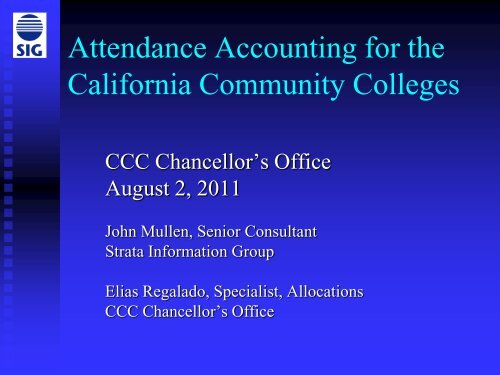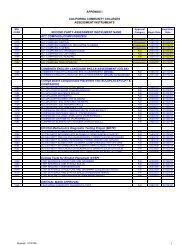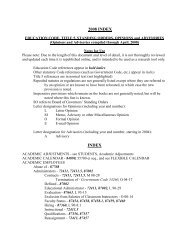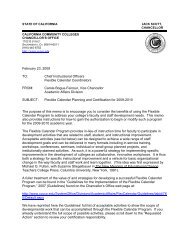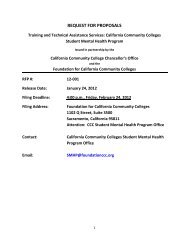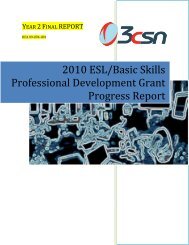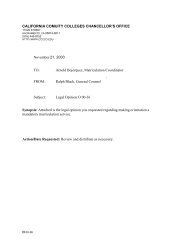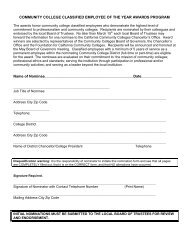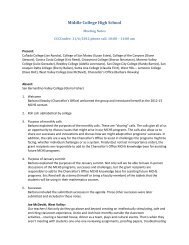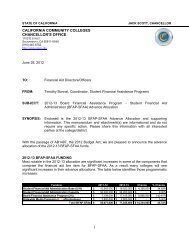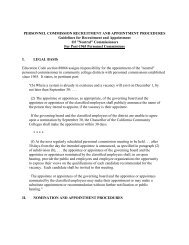Attendance Accounting
Attendance Accounting
Attendance Accounting
You also want an ePaper? Increase the reach of your titles
YUMPU automatically turns print PDFs into web optimized ePapers that Google loves.
<strong>Attendance</strong> <strong>Accounting</strong> for the<br />
California Community Colleges<br />
CCC Chancellor’s Office<br />
August 2, 2011<br />
John Mullen, Senior Consultant<br />
Strata Information Group<br />
Elias Regalado, Specialist, Allocations<br />
CCC Chancellor’s Office
<strong>Attendance</strong> <strong>Accounting</strong> for the<br />
California Community Colleges<br />
Academic Calendar<br />
Census Dates<br />
Open Enrollment Requirement<br />
Apprenticeship Classes<br />
Distance Education<br />
Course Enrollment/Repetition Limits<br />
Residency Requirements
Q: How is Apportionment<br />
Revenue allocated?<br />
A: On the basis of Full-time<br />
Equivalent Students (FTES) in<br />
attendance, as reported to the CCC<br />
Chancellor’s Office on the CCFS-<br />
320 Report three times each year.
Full-Time Equivalent Student<br />
(FTES)<br />
1 FTES =<br />
1 student<br />
15 hours per week<br />
2 semesters of 17.5 weeks<br />
(3 quarters of 11.67 weeks)<br />
= 525 contact hours
Program Funding Based on FTES<br />
Lottery Revenue<br />
Basic Skills Education<br />
Instructional Equipment<br />
Library Materials<br />
Numerous State-funded categorical<br />
programs
<strong>Attendance</strong> <strong>Accounting</strong> for the<br />
California Community Colleges<br />
Sources of Authority<br />
California Legislature<br />
Education Code<br />
Board of Governors of the California Community<br />
Colleges<br />
Title 5 of the California Code of Regulations
Full-Time Equivalent Student<br />
(FTES) Reporting<br />
CCFS-320<br />
Includes Flex Calendar Adjustment<br />
Center FTES<br />
CDCP Noncredit FTES<br />
AB 540 Student Headcount<br />
K-12 Student FTES in PE Classes<br />
CCFS-321 (Apprenticeship)
Full-Time Equivalent Student<br />
(FTES) Reporting Periods<br />
First Period: July 1 – December 31<br />
Second Period: January 1 – April 15<br />
Third Period: April 16 – June 30<br />
Reports due: January 15<br />
April 20<br />
July 15
Full-Time Equivalent Student<br />
(FTES) Reporting Categories<br />
Students who are California residents<br />
Students who are not residents of California<br />
Students enrolled in credit courses<br />
Students enrolled in specified noncredit<br />
courses
Full-Time Equivalent Student<br />
(FTES) Reporting<br />
Clock hour<br />
Class hour<br />
Passing time/break<br />
Partial class hour<br />
Multiple hour class
Clock Hour<br />
A 60-minute time frame that may begin at<br />
any time.<br />
Examples: 0800 to 0900<br />
0810 to 0910<br />
0820 to 0920
Class Hour<br />
A period of not less than 50 minutes of<br />
scheduled instruction or examination<br />
There can be only one “class hour” in each<br />
“clock hour,” except as provided for<br />
multiple hour classes.<br />
A “class hour” is commonly called a<br />
“contact hour” or “Student Contact Hour.”
Passing Time/Break<br />
Each clock hour is composed of one class<br />
hour segment and a segment referred to as<br />
“passing time” or a “break.”<br />
No additional attendance may be claimed<br />
for this 10-minute segment, except for<br />
multiple-hour classes.
Partial Class Hour<br />
The fractional part of a class hour at the end<br />
of multiple hour class<br />
A multiple hour class is defined as a class<br />
scheduled for more than one clock hour.
Multiple Hour Class<br />
Each 50 minutes exclusive of breaks is a<br />
class hour.<br />
A partial class hour beyond the last full<br />
clock hour is counted from the 51 st minute<br />
of the last full clock hour.
Multiple Hour Class<br />
No break is allowed in the last full clock<br />
hour or the partial class hour.<br />
The divisor for this partial class hour is 50.<br />
The total class hours cannot exceed the<br />
clock hours.
Calculate the contact hours:<br />
Class meets from<br />
0900 to 0950<br />
0900 to 1000<br />
0900 to 1005<br />
0900 to 1050<br />
0900 to 1100<br />
0900 to 1105<br />
0900 to 1130<br />
Contact hours:<br />
1.0<br />
1.0<br />
1.3<br />
2.0<br />
2.0<br />
2.3<br />
2.8
<strong>Attendance</strong> <strong>Accounting</strong> Methods<br />
Weekly Student Contact Hour<br />
Daily Student Contact Hour<br />
Actual Hours of <strong>Attendance</strong><br />
(Positive <strong>Attendance</strong>)<br />
Alternative <strong>Attendance</strong> <strong>Accounting</strong> Method<br />
(Independent Study/Work Experience)<br />
Noncredit Distance Education
Weekly Student Contact Hour<br />
Primary terms only<br />
Course coterminous with the primary term<br />
Same number of days each week<br />
Same number of hours each week including<br />
TBA
Census Week<br />
The week nearest to 20% of the number of<br />
weeks in the primary term<br />
Census date is Monday of census week<br />
If that Monday is a holiday, census date is<br />
the following day
Term Length Multiplier<br />
Number of weeks in primary term with at<br />
least three days of instruction and/or<br />
examination<br />
The term length multiplier for each college<br />
is set by the CCC Chancellor’s Office based<br />
on the college’s academic calendar.<br />
Maximum TLM: 17.5 for semesters<br />
11.67 for quarters
FTES Calculation (WSCH)<br />
Multiply Census Week WSCH by the TLM<br />
and divide by 525<br />
(CWSCH x TLM) / 525
Daily Student Contact Hour<br />
Course meets five or more days<br />
Meets same number of hours on each<br />
scheduled day<br />
NOT coterminous with primary term
Census Day<br />
The day of the class meeting that is nearest<br />
20% of the number of days the course is<br />
scheduled to meet<br />
When the census day falls on the first day<br />
the class meets, census is taken on the<br />
second day.
Course Length Multiplier<br />
Number of days the course is scheduled to<br />
meet (CLM)
FTES Calculation (DSCH)<br />
Multiply Census Day DSCH by the Course<br />
Length Multiplier and divide by 525<br />
(CDSCH x CLM) / 525
Positive <strong>Attendance</strong><br />
Based on actual count of enrolled students<br />
present at each class meeting<br />
Courses meeting fewer than five days<br />
Courses irregularly scheduled with respect<br />
to number of days per week or number of<br />
hours on scheduled days<br />
All noncredit courses
FTES Calculation (PA)<br />
Divide total hours of actual attendance by<br />
525<br />
PAH / 525
Alternative <strong>Attendance</strong><br />
<strong>Accounting</strong> Method<br />
(Independent Study / Work Experience)<br />
WSCH method for courses<br />
coterminous with primary term<br />
DSCH method for all other courses
Alternative <strong>Attendance</strong><br />
<strong>Accounting</strong> Method<br />
(Independent Study / Work Experience)<br />
One weekly student contact hour is counted<br />
for each unit of credit for which the student<br />
is enrolled as of the census date or day.<br />
Lab hours, when appropriate, can be added<br />
to the contact hours derived from each unit<br />
of credit.
FTES Calculation (ISWE)<br />
Multiply number of students enrolled as of<br />
census by the number of “weekly contact<br />
hours”; multiply by the term length<br />
multiplier; divide by 525.<br />
(# Students x “WCH” x TLM) / 525
Distance Education (Credit)<br />
Until 2002, all distance education courses<br />
had to be assigned to the Independent<br />
Study/Work Experience attendance<br />
accounting method.<br />
Current regulations allow any appropriate<br />
accounting method to be used for distance<br />
education courses.
Noncredit Distance Education<br />
Calculate the sum of the total hours of<br />
instruction or programming, plus hours<br />
expected for out-of-class work, plus hours<br />
of instructor contact.<br />
Divide that sum by 54, and multiply by the<br />
number of students enrolled as of census<br />
day, and multiply by 17.5. The result is the<br />
number of student contact hours.
Noncredit Distance Education<br />
Report the number of student contact hours<br />
as of two census dates.<br />
First census date is at the 20% point of the<br />
class.<br />
Second census date is at the 60% point of<br />
the class.
FTES Calculation (NCDE)<br />
Compute the average of the student contact<br />
hours as of the two census dates and divide<br />
by 525.<br />
[0.5 x (SCH1 + SCH2)] / 525
Working Together<br />
An Important Partnership<br />
Instruction Office/Divisions/Departments<br />
Develop Schedule of Classes<br />
Build Sections in Computer<br />
Admissions & Records<br />
Manage Admissions and Registration<br />
<strong>Attendance</strong> Reporting by Faculty
The Role of IT<br />
Essential Technical Support<br />
Maintain Hardware and ERP Software<br />
Ensure Data Integrity and Security<br />
Control Access to Data<br />
Support Users<br />
Assist Users in Understanding System<br />
Troubleshoot Problems
Building a Section<br />
Three Critical Characteristics Affecting<br />
<strong>Attendance</strong> Reporting<br />
<strong>Attendance</strong> <strong>Accounting</strong> Method<br />
Meeting Schedule<br />
Contact Hours<br />
Census Date
Building a Section<br />
Determine appropriate attendance accounting<br />
method based on the term, class start/end dates,<br />
and meeting schedule.<br />
Calculate daily or weekly contact hours based<br />
upon scheduled hours of instruction for the<br />
individual section (not the target “catalog” hours<br />
for the course).
Building a Section<br />
For Weekly or Daily Census sections, assign the<br />
appropriate census date.<br />
All Weekly Census sections of a term have the<br />
same census date (Monday of the week nearest the<br />
20% point of the term).<br />
Each Daily Census section has an individual<br />
census date, the day of the class meeting nearest<br />
the 20% point of the course.
Building a Section<br />
Example: MATH 250<br />
Fall Semester – Full term class<br />
MWF 8:00 – 9:15 a.m.<br />
<strong>Attendance</strong> Method: Weekly Census<br />
Contact Hours: 4.5 Weekly Contact Hours<br />
Census Date: Term Census Date
Building a Section<br />
Example: ENGL 120<br />
Spring Semester – 8-week class<br />
T Th 10:10 – 11:15 a.m.<br />
<strong>Attendance</strong> Method: Daily Census<br />
Contact Hours: 1.3 Daily Contact Hours<br />
Census Date: Third Class Meeting
Managing <strong>Attendance</strong> Records<br />
Ensure that instructors of Weekly Census and<br />
Daily Census classes drop inactive students as of<br />
the census date.<br />
Ensure that instructors of Positive <strong>Attendance</strong><br />
classes record and report accurate individual total<br />
hours of attendance for each enrolled student,<br />
including students who drop the class at any point<br />
during the term.
TBA Hours (By Arrangement)<br />
Ensure that TBA hours for Weekly Census classes<br />
are required each week, not as a total number of<br />
hours for the term.<br />
Ensure that TBA hours for Daily Census classes<br />
are required each day, not as a total number of<br />
hours per week or duration of the class.<br />
Ensure that attendance records are kept and that<br />
no TBA hours are reported for Weekly Census<br />
and Daily Census classes for students who have<br />
documented zero hours as of the census point.
FOE (Frequently Observed Errors)<br />
Hybrid courses inappropriately assigned to<br />
Weekly Census or Daily Census method<br />
Daily Census courses with “weekly” lab hours<br />
Summer courses assigned to Weekly Census<br />
Summer intersession courses reported in the<br />
wrong academic year, or reported in both<br />
academic years<br />
Catalog hours reported rather than Schedule hours<br />
TBA hours irregularities
Auditors are asked to:<br />
Verify that district governing boards have adopted<br />
required procedures in line with Title 5 and other<br />
published requirements.<br />
Verify that required tabulations are maintained for<br />
each course section.<br />
Verify that attendance records are retained for the<br />
required retention period.<br />
Verify that an appropriate attendance accounting<br />
method is assigned to each course section.
Auditors are asked to:<br />
Verify that courses are appropriately scheduled in<br />
accordance with Title 5 regulations and guidelines<br />
published by the Chancellor’s Office.<br />
Verify that districts have secured, as applicable,<br />
Chancellor’s Office approval for credit and<br />
noncredit courses, and that all courses have been<br />
approved by the local governing board following<br />
approval by a district/college curriculum<br />
committee.
FTES Reporting Periods<br />
<strong>Attendance</strong> for weekly and daily census sections is<br />
reported in the period in which the census date<br />
falls.<br />
<strong>Attendance</strong> for positive attendance sections is<br />
reported in the period in which the last class<br />
meeting occurs.<br />
Exception: <strong>Attendance</strong> for daily census sections<br />
with census date before July 1 and ending date<br />
after July 1 may be reported in either fiscal year.
CCFS-321 - Apprenticeship<br />
No FTES is calculated<br />
Report actual hours of attendance<br />
Residents and nonresidents together<br />
Estimate annual total at P1<br />
Revise that estimate at P2<br />
Report actual annual hours by July 15
Annualizers<br />
Used to estimate annual FTES at P1 and P2<br />
A separate annualizer is used for each<br />
attendance method at each reporting period.<br />
P1 report is due in Sacramento on January<br />
15.<br />
P2 report is due on April 20.<br />
Annual report is due on July 15.
Annualizers – Example<br />
Calendar has two primary terms<br />
All fall semester WSCH reported in P1<br />
<strong>Attendance</strong> essentially equal each<br />
semester<br />
WSCH annualizer at P1 would be 2.0<br />
WSCH annualizer at P2 would be 1.0
CCFS-320 Flexible Calendar<br />
Units of FTES other than WSCH are<br />
adjusted by a factor to provide same FTES<br />
as would have been generated by regular<br />
instruction instead of flex time activities.<br />
Annual reports of flex hours and total<br />
contact hours by attendance method are<br />
reported at P1, P2 and by July 15.
Reference Documents<br />
Education Code<br />
California Code of Regulations, Title 5<br />
CCC Chancellor’s Office Publications<br />
District Regulations and Procedures
Reference Documents<br />
Contracted District Audit Manual (CDAM)<br />
Section 424 lists criteria related to state<br />
general apportionment funding, including<br />
pertinent Title 5 and Education Code<br />
sections.<br />
Click here to access the 2010-11 CDAM.
Reference Documents<br />
Student <strong>Attendance</strong> <strong>Accounting</strong> Manual<br />
Addendum Concerning Academic<br />
Calendars, Course Scheduling, and Related<br />
Topics<br />
Click here to access the SAAM and<br />
addendum.
Reference Documents<br />
Distance Education Guidelines (2008<br />
Omnibus Version), which provide updated<br />
guidance on attendance accounting for<br />
distance education courses and the<br />
Alternative <strong>Attendance</strong> <strong>Accounting</strong><br />
Procedure<br />
Click here to access the Distance Education<br />
Guidelines.
Reference Documents<br />
Governing board-approved procedures<br />
adopted pursuant to Title 5 Sections<br />
58004(c) and 58030 for documenting course<br />
enrollment, attendance, and disenrollment<br />
to be obtained by auditors from the district<br />
being audited
Reference Documents<br />
List of approved college Term Length<br />
Multipliers issued by the CCC Chancellor’s<br />
Office<br />
Click here for the TLM list.
Reference Documents<br />
CCFS-320 Apportionment <strong>Attendance</strong><br />
Report – CATALOG HOURS vs.<br />
SCHEDULE HOURS<br />
Click here for CATALOG HOURS vs.<br />
SCHEDULE HOURS
Reference Documents<br />
CCC Contact Hours Chart for the<br />
calculation of contact hours in five-minute<br />
increments<br />
Click here for the Contact Hours Chart.
District/College <strong>Attendance</strong> Reports<br />
Contact Hours Summary by <strong>Attendance</strong><br />
<strong>Accounting</strong> Method<br />
Contact Hours by Section within<br />
<strong>Attendance</strong> <strong>Accounting</strong> Method<br />
Section Detail Report<br />
Published Schedule of Classes<br />
Course Outline of Record
Questions and Answers<br />
Contact information:<br />
John Mullen<br />
Strata Information Group<br />
Phone: 650.533.6850<br />
Email: mullen@sigcorp.com<br />
Elias Regalado<br />
Fiscal Services, Chancellor’s Office<br />
Phone: 916.445.1165<br />
Email: eregalad@cccco.edu


